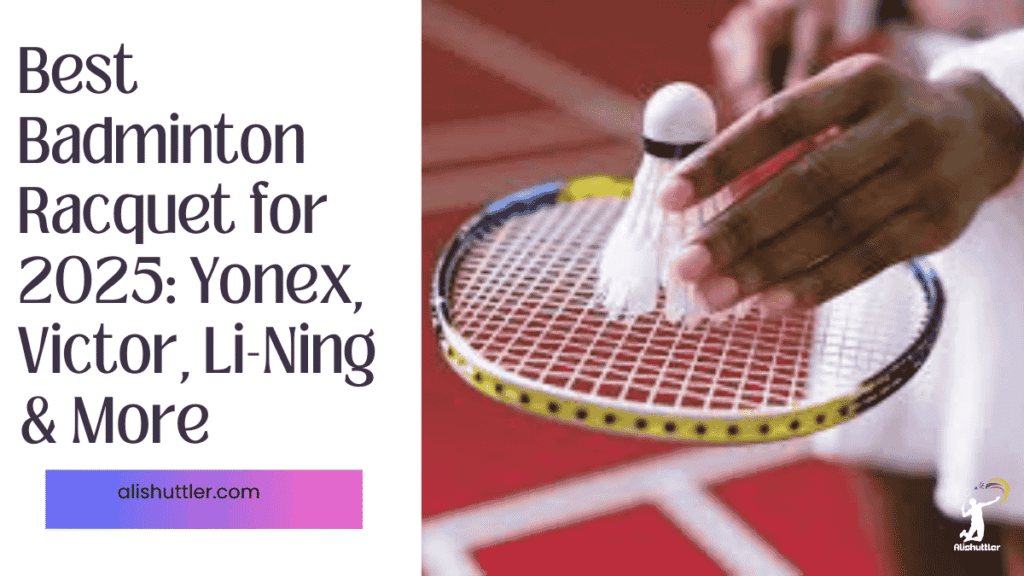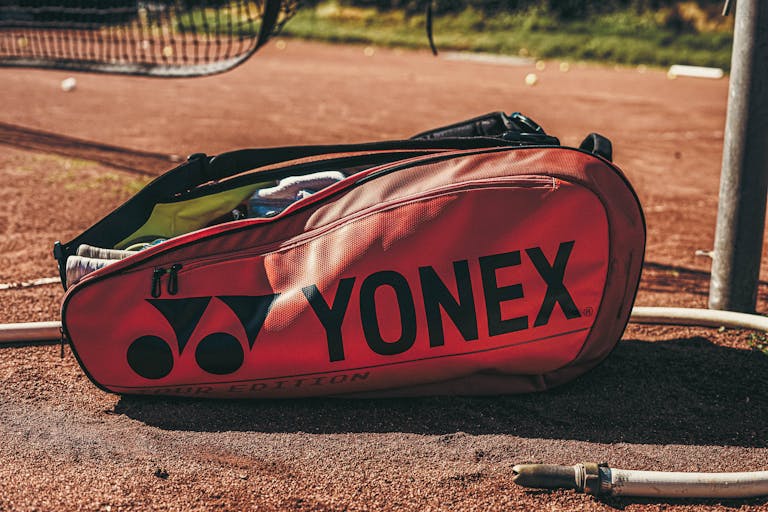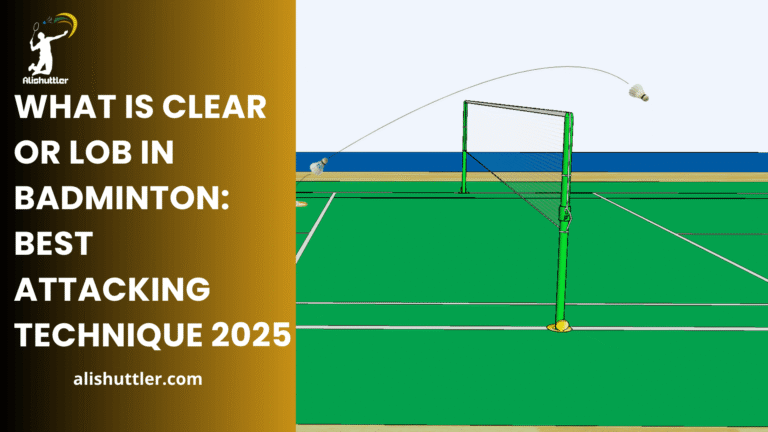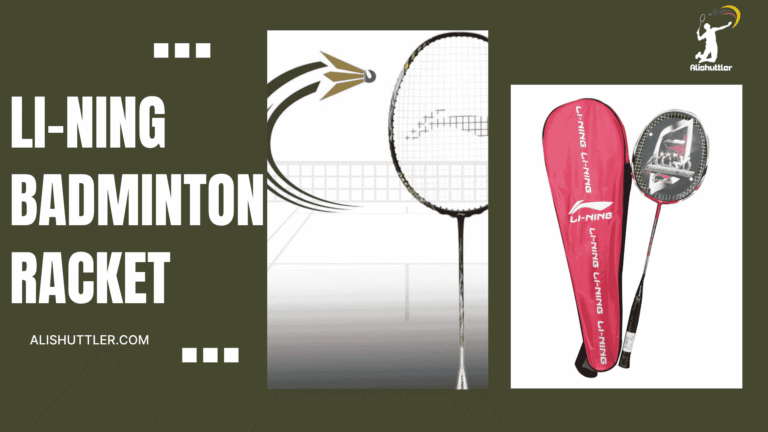In the end, the Best badminton racquet is the one that matches your style, grip, and level of play and provides you with proper balance and control.
Most rackets employ light frames, resilient strings, and easy-grip handles for optimum swings and swift footwork. Some rackets assist with power strokes and others perform well for quick defense or net play.

To get the right one, they consider weight, shape, and grip size that suit them.
Racket Selection
Best badminton racquet significantly influences how you hit, move, and control the shuttle. Selecting a good beginner Best badminton racquet involves aligning its characteristics to your style, skill, and comfort. Each component of a racket balance, weight, shaft, grip size, and strings affects power, speed, and shot precision.
1. Balance for Best badminton racquet
The racket’s balance is the location at which its weight balances along the frame. There are three types: head-heavy, even balance, and head-light.
Head-heavy rackets deliver more punch to every swing. These assist players who want to hit deeper clears or smashes, particularly those who struggle to produce power.
Head-light rackets move the weight closer to the grip. This allows you to respond quickly, switch direction and protect swiftly, making them popular for doubles where speed trumps brawn.
Even balance rackets fall somewhere in between, providing a mix of power and control, and can suit a lot of players, particularly at the intermediate level.
Test hit with both types to see which one keeps your shots crisp and feels good in your hand. The proper tension can be the difference between making and breaking close points.
2. Weight
Racket weight, often ranging anywhere from 80–100 grams, affects the swing and capability of a player to sustain longer rallies.
Lighter rackets like those in the 4U category (80–84g) allow you to swing the racket head faster and are more maneuverable for fast volley-type exchanges, making them a popular choice among doubles players.
Beginners usually pick lighter rackets, as they assist develop skill without wrist or arm fatigue. Heavier rackets provide more stability and can add power to smashes, but require more strength and finesse to direct.
If you feel your arm getting fatigued during extended matches, a lighter racket could allow you to stay in the game longer and maintain your shot accuracy. Experiment with various weights to find what best complements your strength, skill and style.
3. Shaft
The shaft may be stiff or flexible. Stiff shafts are for players with short, sharp swings who like to blast the shuttle flat and fast.
Flexible shafts bend more, assisting those with fluid, relaxed swings to introduce control and loft. Shaft length modifications impact your reach but your shot timing.
Longer shafts provide additional leverage but can shift your swing speed. Try a handful of rackets from each shaft type to determine which fits your swing.
Expert players might opt for stiffer shafts to maximize their aggressive play, whereas novices and intermediates tend to do better with a little added flex.
4. Grip
A good grip is one that feels secure and fits your hand, so it won’t slip during fast rallies. Grip size is noted as G plus a number, with a lower number indicating a fatter handle.
Measure your hand or test them out to determine what fits Best badminton racquet. The grip’s material is important, as well. Tacky grips can help stop sweat and keep control, while softer grips can be more comfortable for longer games.
Replace tattered grips often to prevent blisters and to maintain fresh strokes.
5. Strings
Strings connect you to the shuttle, so their configuration alters much of game play. Higher tension tightens the sweet spot to deliver more precise shots, but requires a better stroke.
Lower tension provides a larger sweet spot and greater forgiveness, which can assist beginners. String type and thickness (gauge) impact both feel and string durability thicker strings are more durable, but can deaden feedback.
Keep an eye on your strings and change them regularly old strings transform winners into error balls.
Player Archetypes
Selecting the optimal Best badminton racquet begins with knowing your player archetype. Most players fit into one of three main archetypes: attacker, defender, or all-rounder. Each has specific requirements in racket weight, balance, and shaft flexibility.
Singles and doubles players might favor different choices. Singles players tend to opt for heavier rackets for stability, and doubles players select lighter ones for easy maneuverability.
Attacker
Attackers relish their dominance of rallies with hard smashes and rapid drives, making a good beginner badminton racket crucial for those just starting their Best badminton racquet journey. Head-heavy rackets suit this group, adding additional weight to the top of the racket for more swing momentum. Stiff shafts aid in energy transfer from the arm to the shuttle, making shots harder and more direct, which is essential for any aspiring badminton player.
Many attackers opt for rackets in the 3U category (85-89g) for extra punch, typical in singles where power trumps speed. Other players, especially intermediate players, desire increased velocity. Lightweight designs, particularly in the 4U category (80-84g), facilitate fast swings, allowing for powerful shots that can overwhelm opponents.
Aerodynamic racket frames are significant as well, because a quicker swing equates to additional strain on the adversary. This is particularly the case in doubles when quick reflexes are required at the net. String tension is important too higher tensions provide more control, while slightly looser strings increase power, helping players master their skills.
Striking the appropriate balance comes down to how much control the player is willing to sacrifice for additional power, ensuring they choose a suitable Best badminton racquet that fits their style and enhances their overall game performance.
Defender
Defensive players use speed and accuracy to repel blows and keep rallies going. Head-light rackets are an excellent choice as the lighter swing-weight allows you to swing swiftly and change direction quickly. This comes in handy in doubles, where switching directions and reacting to smashes occurs constantly.
Flexible shafts assist with shot-placement and soft blocks, allowing for easier returns to hard shots from across the table. Most defenders prefer rackets in the lighter weight range (4U), allowing them to defend aggressively without tiring.
Defense is not just speed. Control and shot placement matter as well, so defenders tend to try out various rackets to find one that feels right in the hand and allows them to steer the shuttle with precision.
Others might opt for even-balanced rackets for a touch more power on counter-attacks. The correct option keeps defenders cool under pressure and adaptable to any style of play.
All-Rounder
All-rounders seek a Best badminton racquet recommendation that is suitable for different situations, rather than just one option. Even-balanced rackets are the staple for this player archetype, as they provide a blend of power, speed, and control. Both singles and doubles players transitioning from the net to the backcourt often select these versatile rackets for their performance in various games.
Most brands produce all-rounder rackets with a medium flex shaft and an overall weight between 3U and 4U. Japanese brands such as Yonex emphasize equilibrium and meticulous build, crafting rackets that excel in both attack and defense, making them a powerful racket choice for many players.
Chinese brands tended to go for strong frames and power, favoring players who flit from style to style in the middle of a match. Taiwanese brands deliver fresh tech and innovation, with frames that slice through wind quicker and endure longer.
All the brands provide minor variations, but all-rounders want to search for rackets that suit their needs not just the tag.
Brand Philosophies
Brand philosophies influence how badminton racket makers create, manufacture, and sell their products. These guiding beliefs inform not just material or performance features, but the culture, values and reputation that each brand carries. Some brands are grounded in heritage and solidity, while others are bold with new technology and new concepts.
Be it quality, innovation or customer satisfaction, a brand philosophy creates a tribe of player loyalty and often an echo of broader cultural or industry currents. A great philosophy helps keep a brand consistent, regardless of how the market or leaders change.
Japanese Precision
Japanese racket makers take pride in their precision engineering, crafting a good beginner badminton racket that showcases subtle nuances in each frame. They utilize advanced materials, such as high-grade graphite and nano mesh, to create a powerful Best badminton racquet with exceptional strength and flexibility. This careful material selection leads to superior durability and immediate responsiveness when the shuttle strikes the strings, which is crucial for any badminton player.
Balance and control are a big part of the Japanese approach, making these rackets fit a wide range of play styles, from defensive to all-around. Yonex and Gosen won the trust of top players for their consistent performance, regardless of pressure. Reliability in the brand’s case stems from a consistency preference and a respect for craft that is often cultural.

This philosophy explains why these rackets are favored by recreational players and professionals alike, as they provide the necessary tools for mastering powerful shots and developing a player’s skillset. Whether you are a beginner player or an intermediate doubles player, finding the right racket can significantly enhance your Best badminton racquet journey, allowing you to focus on improving your game.
Chinese Power
Chinese brands emphasize power and aggressive play, so they are a favorite for attacking players. These are usually characterized by design features like stiff shafts, reinforced frames, and unusual weight distributions designed to help produce forceful smashes and blazing fast drives.
Brands such as Li-Ning and Victor implement innovative technologies like Turbo Charging and Dynamic Optimum Frame to provide players with enhanced shot power and accelerated swing speeds. A lot of competitive players select these rackets for their capacity to keep up with rapid, aggressive rallies.
The audacious colors and pointed forms complement the dynamic, contemporary game style. For those that prize brute power and pace, Chinese rackets provide an unambiguous direction.
Taiwanese Innovation
Taiwanese brands like Victor and Fleet are renowned for driving technology in racket design. They frequently have aerodynamic frames, with lighter materials that help you swing rapid-fire and shift directions in a flash. That R&D emphasis results in distinctive elements, such as energy-absorbing grommets or shock-absorbing handles.
This desire to innovate keeps their rackets current and adaptable for players on all levels. A lot of players appreciate these rackets provide a nice balance of control and power, reflecting the brand’s intention to cater to a diverse array of demands. Taiwanese makers tend to iterate designs with feedback, having a very open mindset.
Personal Fit and Philosophy
What feels good in the hand can trump specs. Different racket frame shapes can make a racket swing differently through the air and differently in terms of shot timing. Some dig oval heads for precise control, others are into isometric for a larger sweet spot.
Things such as carbon fiber, aluminum or composite blends make each racket have a slightly different feel when playing. Having faith in your grip, comfort, and style is key—if you believe in the racket, you’ll often play better matches.
Beyond The Specs
Finding your perfect badminton racket goes beyond just reading datasheets. A good beginner badminton racket takes into account factors like frame shape, material feel, and grip size, which all influence how a racket plays. Every component, including Best badminton racquet balance and flexibility, has the potential to alter your swings and enhance your badminton journey.
Frame Shape
Frame shape isn’t just aesthetics—it influences how air flows around the racket, which can impact both the speed of your swings and the stability of your shots. An isometric head, for instance, provides a larger sweet spot. That’s awesome if you want a little more wiggle room or you’re still perfecting your timing.
A more oval head can provide improved focus in your shots but demands cleaner contacts. The shape shifts equilibrium. A head-heavy shape gives your clears and smashes extra punch, whereas a head-light frame makes your hand faster for net play or furious rallies.
Even balance frames attempt to blend both worlds, offering a versatile choice for all-around style play. Experiment with shapes to discover what makes your swing feel effortless and keeps every shot on target.
Material Feel
How a racket feels, typically, comes down to its materials. Carbon fiber and graphite are popular as they’re lightweight and durable, however the manner in which each absorbs vibration varies. Some rackets absorb shock better than others, which means they’re easier on your arm after grueling matches.
If you game frequently, this can be the difference in comfort. Then there’s durability—graphite rackets can take high string tensions, so you can push your game without stressing your frame. Experiment with various string types to check which provides you better feedback and suits your style, whether you prefer a stiff, snappy sensation or a gentler delivery.
Your Instinct
There’s no two players are the same. Trust your gut when grabbing new rackets. Notice how each feels immediately from the grip — they’re different sizes, and a smaller handle (G5 or G4) could be more comfortable if you’ve got smaller hands.
Swing each racket a couple times. Some will sound quick, others rather lugubrious but strong. If a racket makes you confident on the practice court, it’s probably a good fit. The proper fit can enhance your spin, power, and even your fun, making every match that much more satisfying.
Strings and Tension
Strings get little attention, but they’re crucial for control and power. Thicker strings last longer, thin strings can give you more feel. Tension matters: lower tension (17-20 lbs) gives a bigger sweet spot, which is good for learning.
Professional players may prefer tighter strings (24-27 lbs) for more incisive control, but these require superior technique. Rotate out old strings and monitor tension frequently, as fresh strings keep your shots crisp and consistent.
The String Factor
The string factor is a huge part of what defines the Best badminton racquet’s feel and playability. Strings, known as power or repulsion strings, accomplish far more than simply hitting the shuttle. They establish the mood for your strokes, how much oomph, command, or feel you have with each swing. The type of string and its tension can both alter the racket’s behavior in actual play, impacting your overall performance metrics.
Thicker strings are a rock-steady choice for beginner players. They don’t snap as easily when you miss the sweet spot, which you’re bound to do a lot as a new player. Thicker strings last longer, but you sacrifice some power. On the flipside, thinner strings, 0.68 mm or less, offer greater repulsion and power but break down quicker. This trade-off is why string choice is important at every level, especially when considering a good beginner Best badminton racket.
String tension is another big effect detail. For most novices, lighter tensions (17-20 lbs) are more manageable. These strings behave like a trampoline, providing added rebound to assist clearing the shuttle with less effort. Intermediate players may want to experiment with medium tensions, from 20-24 lbs, for a step up in control without sacrificing too much power.
Advanced players, including many professionals, opt for high tensions above 24 lbs, sometimes even past 30 lbs. This adds more control and accuracy, but it requires solid technique and strong wrists to maximize its potential. There’s always a give-and-take: lower tension boosts power but can mean less string life, while higher tension gives control but not as much power and can make strings break faster.
On top of that, the type of shuttlecock you employ makes a difference. Plastic shuttles are softer and require lower tensions, about 2-3 lbs less than what you’d use with feathers. This maintains the dynamic of the rally and prevents strings from degrading too rapidly, enhancing your ability to play badminton effectively.
Regardless of the string setup, all racket strings deflect or lose tension. I call this tension creep. As strings stretch and loosen, you may experience less control in your shots. It’s not unusual for players to restring Best Badminton Racquet every couple of months or sooner if you play hard or see an actual decline.
New string tech is beginning to emerge on the market. Others are incorporating new materials, such as smart strings and hybrid materials that purportedly last longer or even track string tension shifts. These developments could soon allow players to select strings that fit their style and evolve as their skillset improves.
As the game evolves, being receptive to these shifts will keep you playing your best and help you navigate your Best Badminton Racquet journey effectively.
Future Technology
Racket manufacturers never stop experimenting with new performance enhancements, and many of them stem from the implementation of superior materials and intelligent design. Nanomaterials, for instance, assist in making rackets lighter yet powerful, making them a great option for a good beginner’s Best Badminton Racquet. Certain brands even add tungsten to frames, increasing mass and rigidity, which can result in quicker swings and crisper ball-strikes.
These tweaks assist players squeeze more from every shot, whether they’re blasting or tipping the net. The frame shape and build play a role. Aerodynamic frames and special shaft designs allow the racket to cut through the air with less friction. Isometric and razor frames are special because they reduce air resistance and aid players in swinging faster.
Certain rackets utilize a bravesword profile or an additional slim shaft. This accelerates your response time and facilitates a transition from defense to offense, which is crucial for an intermediate player. Even some leading players say they can tell the difference between two rackets if one has a more aerodynamic frame or a slightly different composition of silicate compounds. Many actually observe when one side of the racket has a different aerodynamic profile than the other.

AI is the other new tool in racket design. Others leverage AI to test thousands of frame shapes and shaft constructions before they ever produce a physical racket. By doing so, it reduces trial and error, assisting brands in discovering the optimal combination of weight, balance and power. While these innovations may sound high-tech, the true worth is in the extent to which they alter the feel or play of a racket.
For a few players, the transition is enormous. They could potentially punch harder, run faster or control the shuttle more skillfully. To others, the shift is slight or even imperceptible. How a racket feels is, of course, always a personal matter. Some gamers notice slight differences immediately, others take more time to distinguish.
It varies based on playing style, training frequency, and even hand strength. Still, the drive for improved rackets never ceases. Every year, brands experiment with new concepts such as rexis shafts and upgraded profiles to assist players of all abilities in their badminton journey.
Final Thoughts on Best Badminton Racquet
To select the best badminton racket, consider your style, skill, and what you want from each match. A few rackets are suited for quick play, while others assist with strength or precision. Big brands give everything they have to new shapes, lighter frames, and fresh ideas. Strings play a major part, altering the feel of every strike.
New tech keeps propelling gear forward, so you’ve got more ways to play your best. Whether you’re a beginner or an experienced player, everyone loves this sport, and the proper equipment can help you grow and have fun on the court. For your next step, visit local shops or online stores, read reviews, and test a few rackets to see which one fits you.
Frequently Asked Questions
What factors should I consider when choosing the best badminton racket?
Consider the weight, balance, and grip size of a good beginner badminton racket, ensuring it matches your skill level and playing style.
How do player types affect racket choice?
Power players often benefit from powerful rackets that are heavier and stiffer, while control players, including recreational players, may prefer a light racket with better racket flexibility.
Are expensive badminton rackets always better?
Not necessarily. Costly rackets might provide cutting-edge materials or technology, but a good beginner badminton racket is one that accommodates your level and comfort.
Which brands are most trusted for badminton rackets?
Yonex, Victor, and Li-Ning are some of the most trusted brands out there, offering a good beginner badminton racket alongside powerful rackets for pro-level players, ensuring quality and ingenuity in every option.
How important are racket strings in performance?
Strings impact power and control, making them essential for a good beginner badminton racket.
What future technologies are emerging in Best Badminton Racquets?
Racket tech advancements, like lighter materials and better aerodynamics, help badminton players enhance their performance metrics, increasing velocity and precision.
Can beginners use professional-level rackets?
New players should go for a good beginner badminton racket that is easy-to-use and comfortable, while professional-level rackets are often too heavy or stiff for beginner players.






